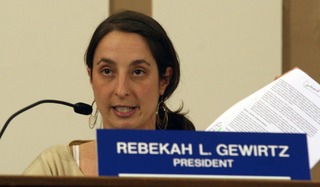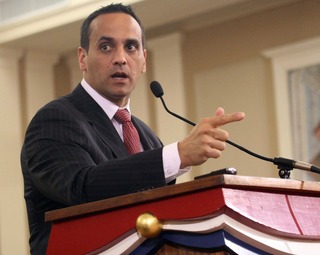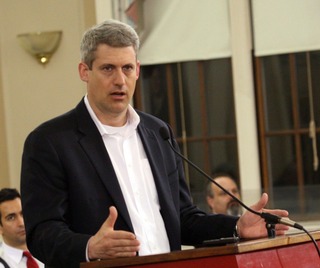
- Photo by Andrew Firestone
By Ashley Taylor
This past Wednesday, April 13, Ward 6 Alderman Rebekah Gewirtz challenged the core of Mayor Joseph Curtatone’s Assembly Square District Improvement Financing (DIF) plan, arguing that Somerville taxpayers cannot afford to shell out for the project.
At a public hearing with the Board of Aldermen, Gewirtz said the city can’t afford to post $25 million in bonds for new infrastructure in Assembly Square. She was retorted by Mayor Curtatone who said that without the city’s commitment to build the infrastructure, the Tri-Party Agreement between the state, the city and the developer to fund the Assembly Square Orange Line station would fall apart, ending the city’s bid to attract new businesses.
“All we have before us are three blocks,” Gewirtz complained of the 400 retail units and about 256,000 squarefeet. of retail space to be developed by Federal Realty Investment Trust (FRIT). “Three buildings. And we’re going to invest $25 million dollars of taxpayer money on hopes and dreams?”

- Photo by Andrew Firestone
Curtatone disagreed. “This is not a gamble. The gamble you would take is if you said, ‘Let’s not do this, let’s see what the state does, the developer does.’ That’s the gamble,” he said.
The city’s plan to use property tax increases from three new retail and apartment buildings in Assembly Square to fund infrastructure improvements has many extenuating factors. Time will tell when FRIT will build the three new buildings and how much property tax revenue they will generate.
City officials differed in their view of this situation. Some, like Gewirtz, think it is a mistake to take an expensive risk when the outcome is uncertain. Yet the city assessor, Marc Levye, explained at the meeting how projected increases in property tax revenue generated by the DIF’s three blocks are predicted to cover debt service on the DIF bonds. Curtatone insists that the risk is necessary for the future of Assembly Square.
District Improvement Financing is a state program in which a city decides to develop a defined area and then apply increases in property taxes within that area to fund the development. The city would post bonds ($25 million) to fund the extension of Assembly Square Drive, installation of a storm water conduit, and construction of internal roadways in Assembly Square The city would pay back the bonds plus interest using money from property tax increases within the district that would result from construction of Blocks 1, 3, and 4 by FRIT.
Gewirtz repeatedly claimed that Somerville residents cannot afford to pay back the $25 million. “What can the taxpayers of the City of Somerville afford? They can’t afford $25 million dollars, which is why we have to take out a bond,” she said.
Curtatone responded that the tax increment from the DIF’s three buildings is sufficient to pay debt service on the bonds. “This is not a burden on the taxpayers of the city. Your property tax, mine, anyone who owns property here, will not see any property tax increase to fund this project.”
According to a table provided by the city assessor, the total tax increment of DIF would be $67 million and the total debt service of the bonds would be $46 million over the DIF’s thirty-year period.
Levye’s predictions did not go without scrutiny.
In the agreement, FRIT shoulders the burden to pay back the city for $15 million in bond principals if they do not reach the core-and-shell stage within three years of breaking ground on the DIF’s three buildings. Aldermen considered the full definition of “core-and-shell” and asked the city assessor to predict the value of the DIF’s three buildings (and the predicted tax increment) at that stage.
“Core-and-shell” is defined as the stage when buildings are at the most basic level of completion; It does not include electrical and plumbing systems outside of life safety systems, floor coverings, or internal walls and partitions.
A sticking point between the aldermen and the city assessor was that the assessor did not specifically determine the value of blocks at the core-and-shell stage. Instead, he determined the value at full build-out, then predicted values during construction (and yearly tax revenue) based on construction being 25% complete in 2012, 75% complete in 2013, and 100% complete by June 30, 2014. Alderman-At-Large William White and others questioned the logic of that approach.
“How can you work backwards from what you’ve been told it’s going to be when it’s not completed?” White asked. “What you have to do is you have to communicate to me that core-and-shell construction, that’s supposed to be in place, is going to be worth what your proposed valuation is, because that means the taxpayers are not going to be footing the bill.,” he continued.
The assessor responded working backwards is a common assessing practice. He said that when assessing buildings under construction, they assign each part of the building a percentage of the total and determine what percentage of construction is complete and what percentage of the total value has been added. Levye listed off various components of core-and-shell construction and assigned them a percentage. “If all those items are there, core-and-shell, that would be 40% finished,” Levye said.

Donald Briggs, Vice President of FRIT. - Photo by Andrew Firestone
Donald Briggs, Vice President of FRIT, added more information about what core-and-shell means. “We’re going to break ground in 2012. It’s going to take us somewhere between 12 and 14 months to get to core and shell completion.” He added that Avalon Bay, FRIT’s residential partner, would put 50 residential units on the market at that point and that retailers can begin to occupy storefronts.
On the other hand, if FRIT broke ground in 2012 and took the maximum three years to reach the core-and-shell stage, the project would be behind the assessor’s predictions, which say that Blocks 1, 3, and 4 will be 100 percent complete in 2015. How far behind would depend on what percentage completion you assign to the core-and-shell stage.
Despite the ambiguity, Curtatone thinks the city needs to take the risk. In his response to Gewirtz, he said, “Let’s make it clear, ‘cause I don’t think it’s accurate to say that. We cannot afford not to go forward. We cannot. The T station will not be built if we don’t put our money down.”
According to the Tri-Party Agreement, the state will only provide its funds for the Assembly Square Orange Line station if the city provides $25 million for the infrastructure improvements in Assembly Square. In that way, the extension of the Orange Line depends on the DIF.
Andrew Firestone contributed editing and reporting for this article.












Reader Comments